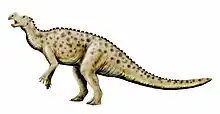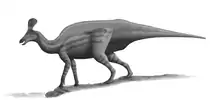Willinakaqe
Willinakaqe is a dubious genus of saurolophine hadrosaurid dinosaur described based on fossils from the late Cretaceous (late Campanian-early Maastrichtian stage) of the Río Negro Province of southern Argentina.
| Willinakaqe Temporal range: Upper Cretaceous, | |
|---|---|
| Scientific classification | |
| Domain: | Eukaryota |
| Kingdom: | Animalia |
| Phylum: | Chordata |
| Clade: | Dinosauria |
| Clade: | †Ornithischia |
| Clade: | †Ornithopoda |
| Family: | †Hadrosauridae |
| Subfamily: | †Saurolophinae |
| Genus: | †Willinakaqe Juárez Valieri et al., 2010 |
| Species: | †W. salitralensis |
| Binomial name | |
| †Willinakaqe salitralensis Juárez Valieri et al., 2010 | |
Discovery and naming
Willinakaqe was first named by Rubén D. Juárez Valieri, José A. Haro, Lucas E. Fiorelli and Jorge O. Calvo in 2010 and the type species is Willinakaqe salitralensis. The generic name means "Southern duck-mimic", in the Mapuche language (willi, "south", iná, "mimic" and kaqe, "duck"). The specific name refers to the Salitral.[1]
Willinakaqe is known from several disarticulated specimens, among them juvenile and adult individuals found at the Salitral Moreno site of the Lower Member of the Allen Formation. The holotype is MPCA-Pv SM 8, a right premaxilla. A second site in the Malvinas Argentinas Partido has rendered additional specimens. Together the material represents the majority of the skeleton.[1] Some of the fossils were previously discussed in the literature as potentially representing a Patagonian lambeosaurine.[2][1]
A revision of the original diagnosis of Willinakaqe salitralensis and of fossil material attributed to this species was published by Cruzado Caballero and Coria in 2016, who argue that the fossils attributed to Willinakaqe salitralensis might represent more than a single taxon of hadrosaurid and that all characters of the original diagnosis are invalid, meanwhile the holotype itself is too weathered and incomplete to support a diagnosis; thus, the taxon Willinakaqe salitrensis must be considered a nomen vanum.[3]
Phylogeny
The describers assigned Willinakaqe to the Saurolophidae within the Hadrosauroidea.[1]
In 2010 cladistic analyses by Prieto-Márquez confirmed that the only two hadrosaurid taxa known from South America, Willinakaqe and Secernosaurus, form a clade within the Saurolophinae.[4] Prieto-Márquez & Salinas 2010, Prieto-Márquez, 2010 and Juárez Valieri e.a. considered "Kritosaurus" australis to be identical to Secernosaurus.[1][4]
Cladogram after Prieto-Márquez, 2010:[4]
| Saurolophinae |
| |||||||||||||||||||||||||||||||||||||||||||||||||||||||||||||||||||||||||||||||||||||||||||||||||||||||||
See also
References
- Rubén D. Juárez Valieri; José A. Haro; Lucas E. Fiorelli & Jorge O. Calvo (2010). "A new hadrosauroid (Dinosauria: Ornithopoda) from the Allen Formation (Late Cretaceous) of Patagonia, Argentina" (PDF). Revista del Museo Argentino de Ciencias Naturales. New Series. 11 (2): 217–231.
- J. E. Powell (1987). "Hallazago de un dinosaurio hadrosáurido (Ornithischia, Ornithopoda) en la Formación Allen (Cretácico Superior) de Salitral Moreno, provincia de Río Negro, Argentina". Congreso Geológico Argentino. 10 (3): 149–152.
- Penélope Cruzado Caballero; Rodolfo Anibal Coria (2016). "Revisiting the hadrosaurid diversity of the Allen Fm.: Re-evaluation of the taxonomic validity of Willinakaqe salitralensis (Ornithopoda, Hadrosauridae) from Salitral Moreno, Río Negro Province, Argentina". Ameghiniana. 53 (2): 231–237. doi:10.5710/AMGH.25.09.2015.2943. S2CID 131244427.
- Albert Prieto-Márquez (2010). "Global phylogeny of Hadrosauridae (Dinosauria: Ornithopoda) using parsimony and Bayesian methods". Zoological Journal of the Linnean Society. 159 (2): 435–502. doi:10.1111/j.1096-3642.2009.00617.x.







